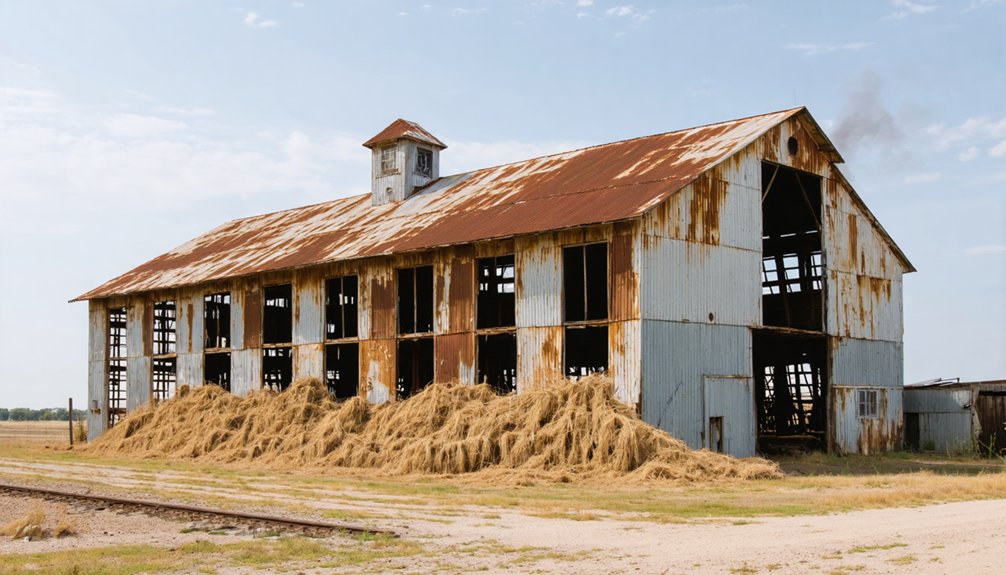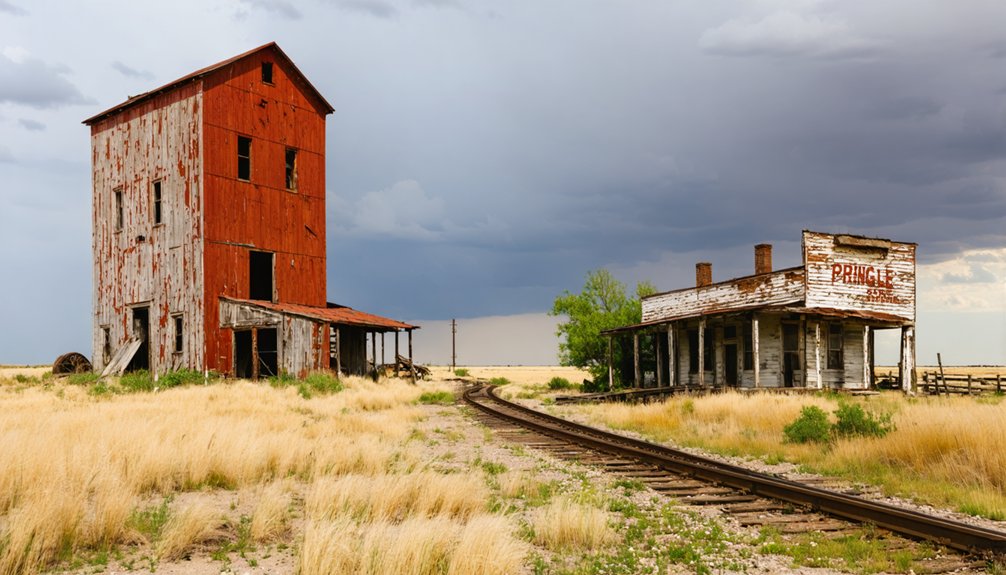You’ll find Pringle, Texas, emerging in 1929 along the Chicago, Rock Island and Gulf Railroad in Hutchinson County. The settlement quickly grew to 60 residents, boasting a post office, 14-room hotel, and schoolhouse that anchored community life. Following World War II, modernization and declining railroad operations led to Pringle’s abandonment. Today, deteriorating wooden structures and a small cemetery stand as silent witnesses to this once-vibrant railroad community‘s story.
Key Takeaways
- Pringle emerged in 1929 along the Chicago, Rock Island and Gulf Railroad tracks, reaching its peak population of around 60 residents in the 1940s.
- The town featured a 14-room hotel, post office, schoolhouse, and various businesses serving railroad workers and local agricultural communities.
- Economic decline began with the shift to diesel locomotives and increased automobile use, leading to population loss and business closures.
- Today, only deteriorating wooden structures, cemetery remains, and abandoned building foundations mark the former railroad settlement’s location.
- The railroad ceased operations in 1975, and by 1987 the tracks were abandoned, completing Pringle’s transformation into a ghost town.
The Birth of a Railroad Settlement
When the Chicago, Rock Island and Gulf Railroad began construction of its Stinnett-to-Hitchland line in 1929, the small settlement of Pringle emerged along its tracks in the Texas Panhandle.
You’ll find that Pringle’s birth followed typical railroad settlement patterns of the early 20th century, where towns sprang up to serve the operational needs of expanding rail networks. The railroad company’s influence shaped the town’s development, from its basic infrastructure to its economic potential. Similar to the Texas and Pacific Railway’s approach, the town utilized a checkerboard pattern for development. This practice of establishing rail settlements dated back to earlier successes like the East Texas Penitentiary line built in 1881.
The same year the tracks were laid, a post office opened in Pringle, cementing its status as an official settlement.
Like many Texas towns born from railroad history, Pringle’s existence centered on supporting transportation and commerce along the line, making it an integral part of the region’s growing rail network.
Life in Early Pringle
Daily life in early Pringle revolved around three main pillars: the railroad operations, local schoolhouse, and scattered agricultural activities.
You’d have found a small but bustling community, where town demographics peaked at around 60 residents in the late 1940s. Early businesses served the needs of railroad workers and local families, though services remained limited. Like Cheapside’s experience with the boll weevil infestation, agricultural challenges shaped the economic landscape of these small Texas towns.
The schoolhouse, established in 1929 on William Pringle’s donated land, became the heart of community gatherings and education. The children of nearby Capps community would attend classes here, as their tiny settlement sat along the same abandoned railroad line.
Life wasn’t always easy in this remote Texas settlement. You’d have needed to travel to nearby Stinnett, nine miles away, for additional services. While the railroad brought essential connections to the outside world, the town’s isolation shaped its character.
As automobiles gained popularity and the post office closed in 1947, Pringle’s importance as a railroad stop gradually diminished.
Economic Forces That Shaped the Town
The abundant natural resources of Pringle initially drew settlers to the area, with its water springs and groves providing crucial support for early agricultural ventures.
Pringle’s pristine springs and lush groves beckoned early pioneers, offering vital resources for farming and settlement.
When the Rock Island Railroad arrived in the early 1900s, it transformed the town’s economic sustainability through enhanced market access and commerce opportunities. During this period, the town’s population grew to over 400 residents.
Local entrepreneurship flourished as businesses emerged to serve railroad crews and travelers. You’d have found three grocery stores, a bank, a 14-room hotel, and crucial services like the blacksmith shop and ice-house. Just as safe river crossings had sparked development in other Texas towns like Plemons, the railroad crossing at Pringle became vital to its growth.
The post office’s establishment in 1893 cemented Pringle’s role as a regional hub.
However, the shift to diesel locomotives and increased automobile use eventually undermined the town’s railroad-dependent economy. As residents sought opportunities in larger towns like Bridgeport and Decatur, Pringle’s commercial significance gradually faded.
Social Fabric and Community Spirit
You’d find the heart of Pringle’s social life at its 14-room hotel, where Saturday night square dances brought the small community together in spirited celebration.
Railroad workers, stopping in Pringle for crew changes and rest periods, mingled with locals at these gatherings, creating a unique social dynamic that bridged the permanent and transient populations.
The hotel’s position near the railroad tracks made it an ideal meeting point where traveling crews could swap stories with townspeople, share meals, and participate in weekend festivities that defined the town’s character. Like many tiny Texas Panhandle towns, Pringle maintained its close-knit atmosphere despite its small population. Similar to Belcherville in its prime, the town boasted a population that supported thirty businesses during its peak years.
Community Gatherings at Hotel
Standing prominently near the Rock Island Railroad’s main line and water tower, Pringle’s 14-room hotel served as more than just lodging—it became the heartbeat of local social life during the town’s heyday.
Much like the Crazy Water Hotel in Mineral Wells, this establishment became a cherished destination for both locals and visitors seeking a memorable gathering place.
Similar to its history as a courthouse and schoolhouse, the building adapted to serve multiple community needs over the decades.
This majestic gathering spot hosted vibrant community celebrations that strengthened the bonds between neighbors and preserved local traditions.
You’d find the hotel’s calendar filled with regular events that brought everyone together:
- Saturday night square dances that drew residents of all ages
- Sunday afternoon picnics following church services
- Milestone celebrations marking weddings and anniversaries
- Informal meetups where farmers and merchants exchanged news
The hotel’s influence extended beyond social events, serving as an economic catalyst that supported local businesses and provided employment opportunities, while attracting railroad workers and travelers who brought fresh perspectives to this tight-knit community.
Railroad Workers’ Social Life
Beyond the hotel’s social gatherings, railroad workers formed their own vibrant community that shaped Pringle’s cultural identity. You’d find them congregating at local saloons and pool halls after their shifts, sharing stories and building camaraderie.
The cultural influences of these diverse workers – from “boomers” following construction jobs to settled families – created a unique social fabric. Their leisure activities included baseball games, boxing matches, and musical gatherings that brought together workers across racial and job classifications.
Local churches and fraternal lodges like the Masons provided additional social networks. When workers weren’t organizing through unions like the Knights of Labor, they’d travel the rail lines to larger towns for entertainment.
Despite segregated living quarters and economic disparities, these social connections helped sustain Pringle’s working community through strikes, layoffs, and economic challenges.
The Era of Decline

As post-World War II modernization swept across Texas, Pringle experienced a steady decline that mirrored many small rural communities throughout the state. The combination of population migration and economic decline created a downward spiral that would ultimately lead to Pringle’s abandonment.
The town’s dissolution unfolded in four distinct phases:
- Essential services began closing, including the post office, marking the erosion of community infrastructure.
- Residents gradually relocated to larger nearby towns, leaving only sparse residential structures behind.
- Commercial activity dwindled as improved highways diverted traffic and trade elsewhere.
- Remaining buildings fell into disrepair or were demolished, with private ownership restricting access to historical sites.
Legacy and Remnants Today
If you visit Pringle today, you’ll find only a handful of deteriorating wooden structures, including an abandoned home and the burned remains of the former elementary school.
The town’s physical legacy is primarily centered around its cemetery, which contains historic gravestones from the settlement’s active period.
While the original post office and most other civic buildings have vanished completely, these few surviving structures serve as silent witnesses to the once-thriving railroad community.
Surviving Town Structures
Though Pringle has largely faded into Texas history, several structural remnants offer glimpses into its past. Today, if you visit the site, you’ll find limited historical remnants scattered across privately owned land, telling the story of this once-thriving community.
- Building foundations and footings remain visible in certain areas, though most original structures have been dismantled or collapsed over time.
- A small cemetery survives as one of the most significant historical markers, reflecting the town’s demographic patterns and mortality rates.
- Several abandoned structures stand in various states of disrepair, with many lacking roofs and proper maintenance.
- Former town lots have transformed into agricultural land, with some historical features now hidden behind private fencing and lacking public access.
Preserving Railroad Heritage
When the Chicago, Rock Island and Gulf Railroad ceased operations in 1975, it marked the beginning of significant changes to Pringle’s railroad heritage.
You’ll find that after Rock Island’s bankruptcy, Texas North Western Railway took control of key segments from Pringle to Liberal and Morse to Etter in 1982. However, by 1987, they’d abandoned tracks from Morse north to Hardesty and Pringle south to Stinnett.
Today, railroad preservation efforts focus on documenting what remains. You can still trace abandoned rail beds and rights-of-way on maps, while some operational trackage survives north of Stinnett.
Though many tracks have been removed, historical documentation continues through local archives and museums, preserving the memory of how these rail lines shaped Pringle’s development as a railroad town.
Frequently Asked Questions
Were Any Famous Outlaws or Criminals Known to Have Passed Through Pringle?
You won’t find any documented outlaw sightings or criminal legends here – there’s no historical evidence that famous outlaws ever passed through, despite the region’s rich history of criminal activity nearby.
What Natural Disasters or Severe Weather Events Affected Pringle’s Development?
You’ll find drought effects were the main natural challenge, limiting agriculture and ranching from the early 1900s. While regional floods impacted the Panhandle, no major disasters specifically struck Pringle.
How Did Native American Tribes Interact With Early Pringle Settlers?
You’ll find limited historical records of tribal alliances or cultural exchanges between Pringle settlers and Native Americans, as most tribes had already been relocated to reservations before significant settlement occurred.
What Was the Average Property Value in Pringle During Its Peak?
Like a fading photograph, you can’t pinpoint exact property values, but based on historical appraisal patterns, you’d estimate the property market peaked between $500-$2000 during the early 1900s boom.
Did Any Movies or Television Shows Ever Film in Pringle?
You won’t find any film history or haunted locations captured on screen here – there’s no documented evidence of movies or TV shows ever filming in this remote ghost town.
References
- https://mix941kmxj.com/the-strange-sad-story-of-a-texas-ghost-town-youll-never-visit/
- https://theforgottensouth.com/cheapside-texas-ghost-town-history/
- https://mix941kmxj.com/shot-of-the-century-legacy-of-forgotten-panhandle-town-revisited/
- http://texasghosttowns.blogspot.com/2011/10/
- https://www.ghosttowns.com/states/tx/pringle.html
- https://en.wikipedia.org/wiki/List_of_ghost_towns_in_Texas
- https://www.texasescapes.com/TexasPanhandleTowns/Pringle-Texas.htm
- https://www.tshaonline.org/handbook/entries/pringle-tx
- https://texascooppower.com/history-of-the-texas-state-railroad/
- https://www.oilandgaslawyerblog.com/texas-pacific-railway-texas-pacific-land-trust-history-railroads-texas/



